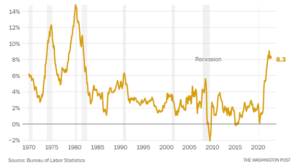
Inflation continues to be the biggest driver of market performance. Here are our thoughts.
After declining in August, stocks and bonds had fared better in September as investors expected inflation levels to ease when August data was released. Oil and gas prices had come down substantially and there had been data showing price declines in airfare, used cars and hotels. Investors expected month over month inflation to come down 0.1% and the annual inflation rate to drop to 8.1% from July’s 8.5%. With a slowing inflation rate, investors had hoped the Federal Reserve could have eased the pace of its Fed funds rate increases, which it uses to combat inflation.

However, inflation surprised to the upside. Investors expected month over month inflation to come down 0.1%, but the actual figure ticked up 0.1% and the annual inflation rate dropped to 8.3%, missing analysts’ estimates of 8.1%. More concerning to investors, core inflation, which excludes the more volatile food and energy categories, increased in August by 0.4% over July and is now up 6.3% over the trailing year. This shows inflation remains strong and broad based. Because of the higher readings, investors expect the Fed to be more aggressive with its monetary policy. As a result, we saw stocks and bonds fall with the total US stock market, as measured by the Russell 3000 Index, drop 4.3% and the total bond market, as measured by the Bloomberg Barclays Aggregate Bond Index, fall 0.5%.
Inflation will likely remain elevated through 2023 with the Fed focusing its tools on reducing it. We expect inflation to continue to be the biggest market driver for the foreseeable future. Future readings showing improvement in inflation will likely drive stocks and bonds higher, while readings showing that inflation remains steady or increases will lead to further potential declines. We recommend continuing to remain disciplined through the market volatility and focused on your portfolio’s long term goals by controlling what you can control and not letting near-term market movements derail long-term plans. In addition, it is important to ensure assets remain segmented appropriately based on the timing of expected cashflows.
*Performance figures as of 9/13/22. Source: Yahoo Finance.

